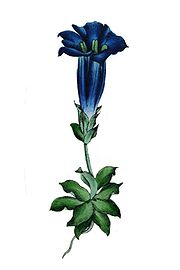
Gentiana acaulis
Encyclopedia
Gentiana acaulis is a small gentian
native to central and southern Europe
from Spain
east to the Balkans
, growing especially in mountain
ous regions, such as the Alps
, Cevennes
and the Pyrenees
, at heights of 800 to 3,000 m.
 It is a perennial plant
It is a perennial plant
, growing on acid
ic soils. Its height is 2 cm and spread is 10 cm or more. The leaves
are evergreen
, 2-3.5 cm long, in a basal rosette, forming clumps. The trumpet-shaped terminal flower
s have a blue colour with olive-green spotted longitudinal throats. They grow on a very short peduncle, 3-6 cm long. The flower stem is often without leaves, or has 1 or 2 pairs of leaves.
It likes full sun, is fully hardy and flowers in late spring and summer.
The closely related Gentiana clusii
, often called by the same common name as this species, differs by growing on limy soils. It also has shorter leaves and the flowers have no olive-green stripes.
Gentian on the obverse side of Austrian € 0.01 euro
coins.
Gentian
Gentiana is a genus of flowering plants belonging to the Gentian family , tribe Gentianeae and monophyletic subtribe Gentianinae. With about 400 species, it is considered a large genus.-Habitat:...
native to central and southern Europe
Europe
Europe is, by convention, one of the world's seven continents. Comprising the westernmost peninsula of Eurasia, Europe is generally 'divided' from Asia to its east by the watershed divides of the Ural and Caucasus Mountains, the Ural River, the Caspian and Black Seas, and the waterways connecting...
from Spain
Spain
Spain , officially the Kingdom of Spain languages]] under the European Charter for Regional or Minority Languages. In each of these, Spain's official name is as follows:;;;;;;), is a country and member state of the European Union located in southwestern Europe on the Iberian Peninsula...
east to the Balkans
Balkans
The Balkans is a geopolitical and cultural region of southeastern Europe...
, growing especially in mountain
Mountain
Image:Himalaya_annotated.jpg|thumb|right|The Himalayan mountain range with Mount Everestrect 58 14 160 49 Chomo Lonzorect 200 28 335 52 Makalurect 378 24 566 45 Mount Everestrect 188 581 920 656 Tibetan Plateaurect 250 406 340 427 Rong River...
ous regions, such as the Alps
Alps
The Alps is one of the great mountain range systems of Europe, stretching from Austria and Slovenia in the east through Italy, Switzerland, Liechtenstein and Germany to France in the west....
, Cevennes
Cévennes
The Cévennes are a range of mountains in south-central France, covering parts of the départements of Gard, Lozère, Ardèche, and Haute-Loire.The word Cévennes comes from the Gaulish Cebenna, which was Latinized by Julius Caesar to Cevenna...
and the Pyrenees
Pyrenees
The Pyrenees is a range of mountains in southwest Europe that forms a natural border between France and Spain...
, at heights of 800 to 3,000 m.

Perennial plant
A perennial plant or simply perennial is a plant that lives for more than two years. The term is often used to differentiate a plant from shorter lived annuals and biennials. The term is sometimes misused by commercial gardeners or horticulturalists to describe only herbaceous perennials...
, growing on acid
Acid
An acid is a substance which reacts with a base. Commonly, acids can be identified as tasting sour, reacting with metals such as calcium, and bases like sodium carbonate. Aqueous acids have a pH of less than 7, where an acid of lower pH is typically stronger, and turn blue litmus paper red...
ic soils. Its height is 2 cm and spread is 10 cm or more. The leaves
Leaf
A leaf is an organ of a vascular plant, as defined in botanical terms, and in particular in plant morphology. Foliage is a mass noun that refers to leaves as a feature of plants....
are evergreen
Evergreen
In botany, an evergreen plant is a plant that has leaves in all seasons. This contrasts with deciduous plants, which completely lose their foliage during the winter or dry season.There are many different kinds of evergreen plants, both trees and shrubs...
, 2-3.5 cm long, in a basal rosette, forming clumps. The trumpet-shaped terminal flower
Flower
A flower, sometimes known as a bloom or blossom, is the reproductive structure found in flowering plants . The biological function of a flower is to effect reproduction, usually by providing a mechanism for the union of sperm with eggs...
s have a blue colour with olive-green spotted longitudinal throats. They grow on a very short peduncle, 3-6 cm long. The flower stem is often without leaves, or has 1 or 2 pairs of leaves.
It likes full sun, is fully hardy and flowers in late spring and summer.
The closely related Gentiana clusii
Gentiana clusii
Gentiana clusii is a large-flowered, short-stemmed gentian, which is very similar to G. acaulis. The two species differ in the presence or absence of green stripes inside the corolla, by the shape of the corners between the petals Gentiana clusii (sometimes called "Clusius' gentian") is a...
, often called by the same common name as this species, differs by growing on limy soils. It also has shorter leaves and the flowers have no olive-green stripes.
Gentian on the obverse side of Austrian € 0.01 euro
Austrian euro coins
Austrian euro coins have a unique design for each denomination, with a common theme for each of the three series of coins. The minor coins feature Austrian flowers, the middle coins examples of architecture from Austria's capital, Vienna, and the two major coins famous Austrians...
coins.

